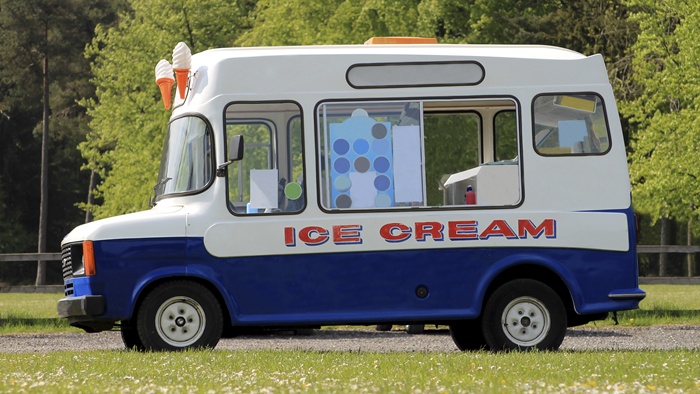
So here I am at the park with my son Quinton. He’s almost five and a hyperactive monkey when it comes to running up the slide (regardless of kids hurtling down) and hanging one-armed from the bars on the play structure. Possibly the next Cirque de Soleil star in a dozen years or so—but who wants their kid to run away with the circus?
I’m more interested in him growing up healthy, happy and strong.
He’s having a great time and all is gold on this sunny near-summer evening until that familiar carnival music, belted out on loudspeaker, comes into range. And there it is, in all its over-priced, low-quality glory: The ice cream truck!
I hate the ice cream truck man. Why? Because, for one thing, I don’t have any money on me, so I’m the parent or grandparent who has to say no to the kid while everyone else runs madly over to the truck as it pulls up to the curb, clamoring to be first in line for a treat. Adults are helpless in this case. No one wants to deny their child the occasional ice cream treat or mess with this precious memory of childhood bliss.
Except me. Because I came without cash to the park—and I can think of better things for my kid to snack on than frozen, processed goop-on-a-stick (or cone). Am I alone in this tirade against the nameless, faceless man behind the wheel? Who’s with me?
The fact is kids should not have a junk food “treat” every day. Make it now and again, and make it something of quality. Like a scoop of real dairy ice cream with some fresh berries or banana slices on top or real chocolate syrup (melt a few squares of good quality chocolate yourself, instead of using the store-bought stuff with artificial sweeteners and additives).
We’re a continent drowning our health in bad food, take-out dinners, processed food in a box, and mini-packages of Skittles or gummy bears alongside the sandwiches in our kids’ lunch boxes at school. All those empty calories and questionable food ingredients add up, hitting us over the head with problems like childhood obesity and related early onset of diabetes and high blood pressure (conditions once mainly diagnosed in adults, now commonly affecting kids under 12).
And have we thought about what sugar is doing to our own bodies? Or the developing minds and bodies of our little ones?
While experts debate whether sugar is addictive and causes poor concentration and hyperactivity, we do know that the body needs natural sugar and carbohydrates, found in fruits and vegetables, for example, for energy. They provide fuel to keep us motoring along.
As a mom, I think the problem with sugar-laden, grocery-store treats (and faux ice cream from the popular truck window) is the empty, useless calories. And the expectation held by kids that these types of foods are ideal.
A Good Humor-Breyers Klondike Bar, from the ice cream truck, has 12 grams of sugar (the entire daily sugar total recommended for kids four to eight). But this is harmless in many minds, because at least our kids are outside in the fresh air burning off calories, deserving of a cooling treat. Many of us don’t think twice about the McDonald’s pit-stop for an ice cream sundae on a hot day. This popular restaurant’s Hot Fudge Sundae has 48 grams of sugar, in case you’re wondering.
As the Mayo Clinic puts it: “The ugly truth is that added sugar means empty calories (no nutrients beyond calories) that put kids at risk of obesity and health problems that can show up as early as adolescence.”
When it comes to identifying added sugar, what should you look for? Check the ingredients on food labels for processed foods, such as breads, cakes, soft drinks, jams, and ice cream. Examples of added sugar run the gambit, including white sugar, brown sugar, raw sugar, corn syrup, corn syrup solids, high fructose corn syrup, malt syrup, maple syrup, pancake syrup, fructose sweetener, liquid fructose, honey, molasses, anhydrous dextrose, crystal dextrose, and dextrin.
Don’t forget sugar-laden culprits like cereal and flavored yogurt as well.
My concern is that sugary sweet treats have become the No. 1 way we pacify and reward our kids. You did well on a test! Great, let’s go out for dessert! Or at least break out the McCain Deep ’n Delicious cake that’s waiting in the freezer. Kids who don’t have related health issues now carry this social expectation into adulthood, consuming sugary foods when they’re happy, sad, or in need of an afternoon treat, which leads to health problems.
Why not mark achievements and celebrations with an activity like a night at the bowling alley or glow in the dark mini golf? Let’s turn spending time with our kids or grandkids into building a stockpile of great childhood memories.
Surely, if we can’t tame our sweet tooth as grown-ups, we owe it to kids to set them on a good path. As adults, we do have a say in what our children and grandchildren eat. We do have a responsibility and can help protect and nurture their health and development.
And the bottom line is, no matter how available processed sweets are to kids, we can exert control, especially when they’re little, plying them with healthy whole foods and setting an example with what we eat ourselves. If more kids bring healthy no-junk-allowed lunches to school, kids across the board will eat better. If we have a homemade smoothie for breakfast with our kids and the occasional homemade banana splits for the family dinner dessert, we’ll all be better off.
Sources:
Nelson, J. K., and Zeratsky, K., “Kids and sugar – The good, the bad and the ugly,” Mayo Clinic, March 21, 2012; http://www.mayoclinic.org/healthy-living/nutrition-and-healthy-eating/expert-blog/kids-and-sugar/bgp-20056149.
“Nutrition Centre,” McDonald’s website; http://www.mcdonalds.com/us/en/food/product_nutrition.dessertsshakes.182.hot-fudge-sundae.html#, last accessed June 2014.
“Calories in Klondike Bar,” SparkPeople website; http://www.sparkpeople.com/calories-in.asp?food=klondike+bar, last updated on October 25, 2013.













